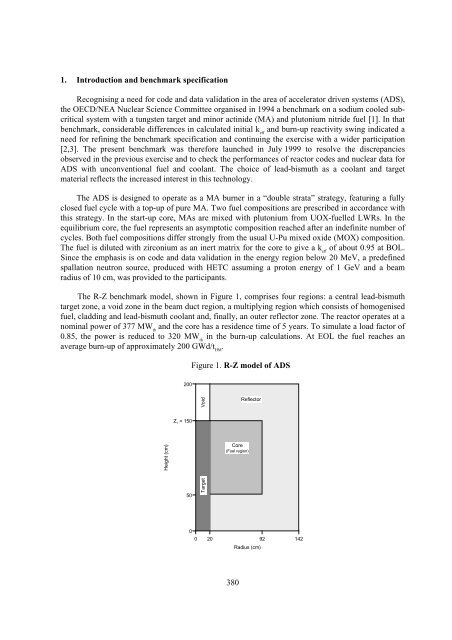OECD/NEA Benchmark Calculations for Accelerator Driven Systems
OECD/NEA Benchmark Calculations for Accelerator Driven Systems
OECD/NEA Benchmark Calculations for Accelerator Driven Systems
You also want an ePaper? Increase the reach of your titles
YUMPU automatically turns print PDFs into web optimized ePapers that Google loves.
1. Introduction and benchmark specification<br />
Recognising a need <strong>for</strong> code and data validation in the area of accelerator driven systems (ADS),<br />
the <strong>OECD</strong>/<strong>NEA</strong> Nuclear Science Committee organised in 1994 a benchmark on a sodium cooled subcritical<br />
system with a tungsten target and minor actinide (MA) and plutonium nitride fuel [1]. In that<br />
benchmark, considerable differences in calculated initial k eff<br />
and burn-up reactivity swing indicated a<br />
need <strong>for</strong> refining the benchmark specification and continuing the exercise with a wider participation<br />
[2,3]. The present benchmark was there<strong>for</strong>e launched in July 1999 to resolve the discrepancies<br />
observed in the previous exercise and to check the per<strong>for</strong>mances of reactor codes and nuclear data <strong>for</strong><br />
ADS with unconventional fuel and coolant. The choice of lead-bismuth as a coolant and target<br />
material reflects the increased interest in this technology.<br />
The ADS is designed to operate as a MA burner in a “double strata” strategy, featuring a fully<br />
closed fuel cycle with a top-up of pure MA. Two fuel compositions are prescribed in accordance with<br />
this strategy. In the start-up core, MAs are mixed with plutonium from UOX-fuelled LWRs. In the<br />
equilibrium core, the fuel represents an asymptotic composition reached after an indefinite number of<br />
cycles. Both fuel compositions differ strongly from the usual U-Pu mixed oxide (MOX) composition.<br />
The fuel is diluted with zirconium as an inert matrix <strong>for</strong> the core to give a k eff<br />
of about 0.95 at BOL.<br />
Since the emphasis is on code and data validation in the energy region below 20 MeV, a predefined<br />
spallation neutron source, produced with HETC assuming a proton energy of 1 GeV and a beam<br />
radius of 10 cm, was provided to the participants.<br />
The R-Z benchmark model, shown in Figure 1, comprises four regions: a central lead-bismuth<br />
target zone, a void zone in the beam duct region, a multiplying region which consists of homogenised<br />
fuel, cladding and lead-bismuth coolant and, finally, an outer reflector zone. The reactor operates at a<br />
nominal power of 377 MW th<br />
and the core has a residence time of 5 years. To simulate a load factor of<br />
0.85, the power is reduced to 320 MW th<br />
in the burn-up calculations. At EOL the fuel reaches an<br />
average burn-up of approximately 200 GWd/t HM<br />
.<br />
Figure 1. R-Z model of ADS<br />
200<br />
Void<br />
Reflector<br />
Z T<br />
= 150<br />
Height (cm)<br />
Core<br />
(Fuel region)<br />
50<br />
Target<br />
0<br />
0<br />
20 92 142<br />
Radius (cm)<br />
380

















